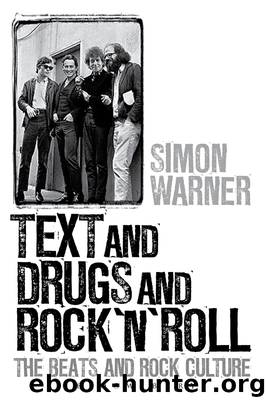Text and Drugs and Rock 'n' Roll by Simon Warner

Author:Simon Warner [Warner, Simon]
Language: eng
Format: epub
ISBN: 9781441171122
Publisher: Bloomsbury Publishing PLC
Notes
1Kerouac appeared on the television show Steve Allen on 16 November 1959. See Miles, 1998, p. 263.
2Maynard G. Krebs was the resident beatnik on the 1959 TV sitcom The Many Loves of Dobie Gillis. See Henry Cabot Beck, ‘From Beat to beatnik’, The Rolling Stone Book of the Beats: The Beat Generation and the Counterculture, edited by Holly George-Warren (London: Bloomsbury, 1999), p. 95.
3For example, ‘Kansas squares (Hutchinson, Kansas) vs. Coast beatniks (Venice, California)’, Life, 21 September 1959.
4Caen claimed he didn’t mean the word ‘beatnik’ in the pejorative sense and attempted to defend it to Kerouac himself. See Ann Charters, Kerouac (London: André Deutsch, 1974), p. 268.
5The shortening of the term popular ‘gave the word a lively informality but opened it, more easily, to a sense of the trivial’. See Raymond Williams, Keywords: A Vocabulary of Culture and Society (London: HarperCollins, 1988), p. 238.
6Note that in 1967, in a major BBC shake-up, the Light Programme would become Radio 2 and the new Radio 1, a response to the rise of pirate broadcasting in the offshore waters of Britain, would become the UK’s Top 40 station.
7Public houses, more colloquially ‘pubs’, are licensed to serve alcoholic drinks only those over the age of 18.
8In Soho, London, the 2i’s Coffee Bar played host to artists like Tommy Steele and Cliff Richard at the end of the 1950s.
9The Wild One was released in the US in 1953 but was banned in the UK by the British Board of Film Certification until 1968.
10The term ‘Teddy’ was drawn from Edward, King Edward VII, who would succeed his mother Queen Victoria in 1902 and sit on the throne until his own death in 1910.
11Melly, 1989, pp. 33–4.
12Lonnie Donegan’s ‘Rock Island Line’ entered the UK charts on 6 January 1956 and reached No. 8. It achieved the same heights in the US charts, entering on 31 March just weeks later.
13The UK charts, as Donegan struck, were a relatively new innovation. The pop weekly New Musical Express had launched the first such listing, a Top 12 based on the best-selling singles of the week, as recently as 1952.
14MacColl said: ‘Skiffle took over, and then the machine took over the skiffle movement, castrated it and robbed it of all its energy.’ See Robin Denselow, 1989, pp. 17–18.
15R.J. Ellis, ‘From “The Beetles” to “The Beatles”: The British/Beat 1955–1965’, Symbiosis, 4.1, April 2000, pp. 67–98 (p. 76).
16Seeger had to fight the possibility of a 10-year jail term after the HUAC subpoenaed him in 1955. See Denselow, 1989, p. 15.
17Alan Lomax was the son of John A. Lomax who was also a significant folklorist.
18The Empire Windrush was the vessel that brought the first influx of post-war Caribbean settlers to the UK in 1948. See Mike Phillips, ‘Windrush – the passengers’, BBC History, 3 October 2011, http://www.bbc.co.uk/history/british/modern/windrush_01.shtml [accessed 19 February 2012].
19It is, nonetheless, worth noting that the matter of race was not entirely absent from the British scene during this era. In London, the Notting Hill Riots of 1958 saw Caribbean arrivals in clashes
Download
This site does not store any files on its server. We only index and link to content provided by other sites. Please contact the content providers to delete copyright contents if any and email us, we'll remove relevant links or contents immediately.
4 3 2 1: A Novel by Paul Auster(11791)
The handmaid's tale by Margaret Atwood(7450)
Giovanni's Room by James Baldwin(6810)
Asking the Right Questions: A Guide to Critical Thinking by M. Neil Browne & Stuart M. Keeley(5357)
Big Magic: Creative Living Beyond Fear by Elizabeth Gilbert(5353)
Ego Is the Enemy by Ryan Holiday(4958)
On Writing A Memoir of the Craft by Stephen King(4664)
The Body: A Guide for Occupants by Bill Bryson(4584)
Ken Follett - World without end by Ken Follett(4444)
Bluets by Maggie Nelson(4261)
Adulting by Kelly Williams Brown(4235)
Eat That Frog! by Brian Tracy(4149)
Guilty Pleasures by Laurell K Hamilton(4118)
White Noise - A Novel by Don DeLillo(3829)
The Poetry of Pablo Neruda by Pablo Neruda(3816)
Fingerprints of the Gods by Graham Hancock(3738)
Alive: The Story of the Andes Survivors by Piers Paul Read(3731)
The Book of Joy by Dalai Lama(3698)
The Bookshop by Penelope Fitzgerald(3619)
